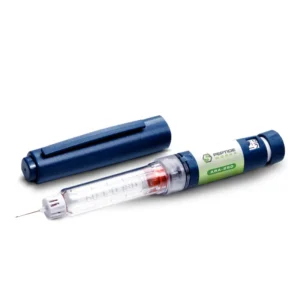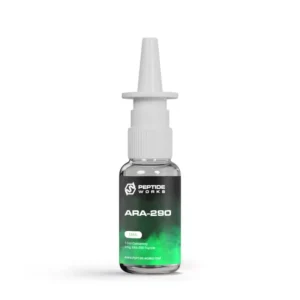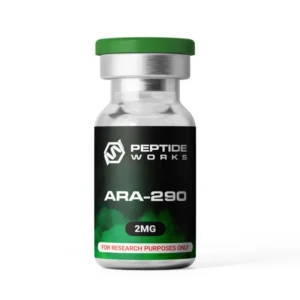PROMO!
First order? Get 10% OFF with this code: 1storder
Our Product Categories



ARA-290 peptide is a synthetic compound derived from erythropoietin (EPO), designed to provide therapeutic benefits without the hematopoietic effects typically associated with EPO. Its main research focus is on its potential to treat chronic inflammatory and neuropathic conditions.
The peptide works by targeting specific receptors to help repair tissue and reduce inflammation. This shows promise for treating diseases related to nerve damage and chronic inflammation. Specifically, it is being studied for conditions like sarcoidosis, diabetes-related complications, and other inflammatory disorders. ARA-290 offers a new approach in peptide-based therapies, providing targeted benefits with a good safety profile.
Peptide Sequence (IUPAC Condensed): H-Pyr-Glu-Gln-Leu-Glu-Arg-Ala-Leu-Asn-Ser-Ser-OH
Molecular Formula: C51H84N16O21
Molecular Weight: 1257.3 g/mol
Synonyms: Cibinetide
View the ARA-290 COA
View the ARA-290 HPLC

ARA-290 works by activating the innate repair receptor (IRR), a special receptor made up of the erythropoietin receptor (EPOR) and CD131. Unlike erythropoietin, which increases red blood cell production, ARA-290 targets this receptor to reduce inflammation and aid tissue repair without affecting blood cells.
When the peptide binds to the IRR, it activates processes that help reduce inflammation. It also protects cells from damage and promotes tissue healing. This makes it especially useful for conditions involving chronic inflammation or nerve injuries. It helps restore normal cell function and relieve symptoms without the risks associated with traditional erythropoietin-based treatments.
Reduces Inflammation: Research has shown the peptide to offer anti-inflammatory and neuroprotective effects without stimulating hematopoiesis. A study on rats with experimental autoimmune encephalomyelitis (EAE) showed that ARA significantly reduced disease severity and inflammation.
It worked by suppressing pro-inflammatory cytokines, reducing T-cell activity, and encouraging Th2 and Treg cells while blocking Th1 and Th17 cells. These findings suggest ARA290 as a potential therapeutic candidate for multiple sclerosis [1].
Relief for Neuropathic Pain: Research indicates that this peptide could be a painkiller or a tissue-protective agent for such diseases as diabetes and cancer. Its analgesia is largely attributed to its anti-inflammatory and immune-modulating effects through the innate repair receptor (IRR).
But a study from 2016 suggested that it might also act directly on those peripheral nociceptors. The research discovered ARA 290 can inhibit activity of TRPV1 channels and alleviate pain triggered by capsaicin. This means that it may be act as an antagonist of TRPV1, potentially providing new opportunities for treating pain and exploring the relationship between the immune and nervous systems [2].
Tissue Repair & Healing: This peptide helps protect and heal tissue by activating the innate repair receptor (IRR), reducing inflammation, and speeding up wound healing.
In studies on diabetic wound models, ARA-290 was shown to improve collagen production, increase protein content and antioxidant levels, and lower inflammatory cytokines. This highlights its potential as a therapeutic option for diabetes-related wound healing [3].
Improves Metabolic Control: ARA-290 enhances metabolic control in type 2 diabetes by improving HbA1c levels, lipid profiles, and cardiovascular risk factors. It helps improve pancreatic islet cell function, boosting glucose oxidation, ATP production, and insulin secretion to support better glucose regulation. Additionally, it eases neuropathic symptoms and helps protect against complications like diabetic retinopathy and nephropathy [4].
Cardiovascular Health: Aging is associated with higher levels of inflammation, oxidative stress, and mitochondrial problems, which can lead to frailty and heart issues. Researchers tested ARA290 on aged rats over 15 months and found it reduced heart inflammation, fibrosis, and pro-inflammatory markers.
It also improved mitochondrial function, autophagy, and overall heart structure. It preserved heart function, lowered blood pressure, reduced frailty, and ultimately extended healthspan while slowing age-related decline [5].
Regenerates Corneal Nerves: Research has shown that the selective IRR agonist enhances corneal nerve regeneration, relieves neuropathic pain and enhances the quality of life for patients. with sarcoidosis and type 2 diabetes. By activating anti-inflammatory and tissue repair pathways, it facilitates recovery from nerve damage with minimal side effects. More research is needed to confirm its long-term benefits [6].
[1] H Chen, B Luo, X Yang, J Xiong, et al (2014). Therapeutic effects of nonerythropoietic erythropoietin analog ARA290 in experimental autoimmune encephalomyelitis rat – Journal of Neuroimmunology, Volume 268, Issues 1–2, 15 March 2014, Pages 64-70.
[2] W Zhang, G Yu, and M Zhang (2016). ARA 290 relieves pathophysiological pain by targeting TRPV1 channel: Integration between immune system and nociception – Peptides, Volume 76, February 2016, Pages 73-79.
[3] M Mashreghi, Z Bayrami, N Asemi Sichani, Sara Salamat, et al (2023). An in vivo investigation on the wound-healing activity of Specific ligand for the innate repair receptor, ARA290, using a diabetic animal model doi: 10.21203/rs.3.rs-2520194/v1
[4] C Muller, K Yassin, L-S Li, M Palmblad, et al (2015). ARA290 Improves Insulin Release and Glucose Tolerance in Type 2 Diabetic Goto-Kakizaki Rats – Molecular Medicine, 2015 Dec 29, Volume 21 (Issue 1), Pages 969–978.
[5] N M Winicki, A P Nanavati, C H Morrell, J M Moen, et al (2023). A small erythropoietin derived non-hematopoietic peptide reduces cardiac inflammation, attenuates age associated declines in heart function and prolongs healthspan – Frontiers in Cardiovascular Medicine, 2023 Jan 18, Volume 9, Page 1096887.
[6] A Dahan, M Brines, M Niesters, A Cerami, and M van Velzen (2016). Targeting the innate repair receptor to treat neuropathy – Pain Reports, 2016 Aug 9, Volume 1 (Issue 1), Page e566.
The answers to the most frequently asked questions about ARA-290.

Buy ARA-290 Peptide Nasal Spray from Peptide Works. The spray is available in 15ml and 30ml glass spray bottles.
Ara-290 and EPO both originate from the same protein, but their functions differ significantly. Ara-290 is designed to specifically target the innate repair receptor (IRR), promoting anti-inflammatory responses and tissue repair. Unlike EPO, Ara-290 does not stimulate red blood cell production, which minimizes the risk of side effects such as blood clots.
It is being researched for its potential to treat: small fiber neuropathy (SFN), sarcoidosis, chronic inflammatory conditions, neuropathic pain, and autoimmune diseases.
Potential benefits include: a reduction in chronic inflammation, relief from neuropathic pain, improved nerve function in small fiber neuropathy, and enhanced tissue repair and healing.
Its long-term safety is still under investigation. Clinical trials are ongoing to evaluate its long-term safety and effectiveness.
Clinical studies have shown the peptide to be generally well-tolerated. Reported side effects are typically mild and may include injection site reactions, fatigue, or headaches. However, further research is necessary to assess its safety profile fully.

This blog looks at how the ARA-290 peptide could help manage chronic neuropathic pain. It explains how ARA-290 works to repair damaged nerve fibers, block pain signals, and reduce how often spontaneous pain episodes occur. It also covers other helpful peptides like BPC 157 and explores the future of peptide-based therapies in treating the underlying causes of neuropathic pain.

This blog looks at how the ARA-290 peptide could help diabetic patients by tackling issues like nerve damage and poor nerve health. It covers research showing ARA-290’s ability to reduce inflammation, support nerve repair, and enhance quality of life. The blog also touches on other diabetes-related problems, such as vision issues, heart health, and the potential for future peptide-based treatments.

This blog explains how AMPK activation helps improve metabolic control in diabetes. It covers insulin sensitivity, GLUT4 transport, fat burning, and energy balance, showing how these cellular processes regulate blood sugar levels. It also looks at new peptide research, future scientific directions in metabolic regulation, and how these findings may guide advanced therapeutic studies.
ALL CONTENT AND PRODUCT INFORMATION AVAILABLE ON THIS WEBSITE IS FOR EDUCATIONAL PURPOSES ONLY.
DISCLAIMER: These products are intended solely as a research chemical only. This classification allows for their use only for research development and laboratory studies. The information available on our Peptide Works website: https://peptide-works.com/ is provided for educational purposes only. These products are not for human or animal use or consumption in any manner. Handling of these products should be limited to suitably qualified professionals. They are not to be classified as a drug, food, cosmetic, or medicinal product and must not be mislabelled or used as such.